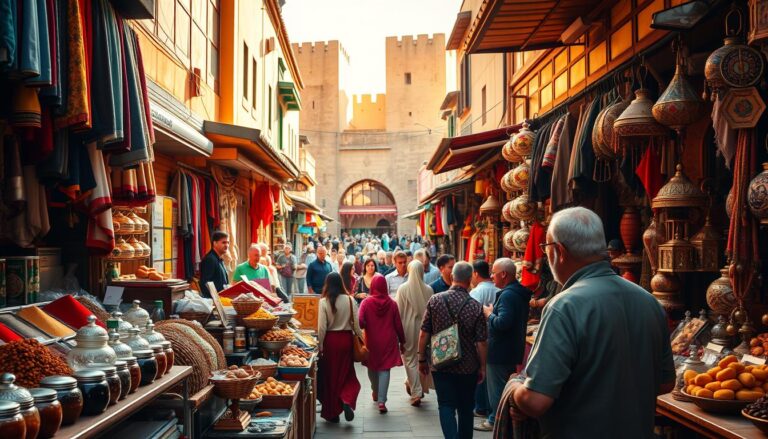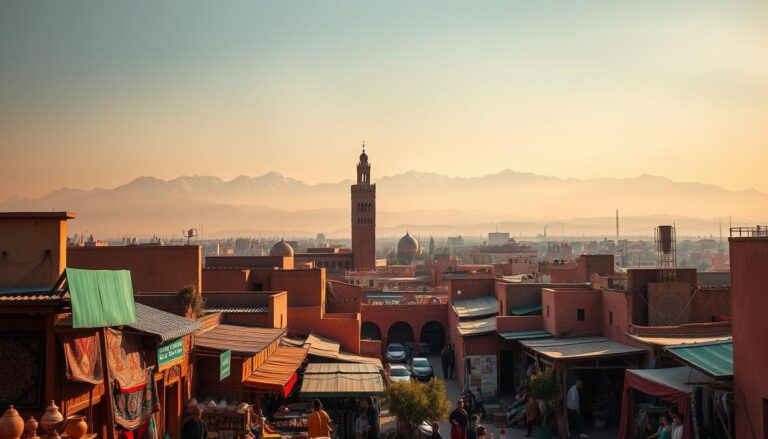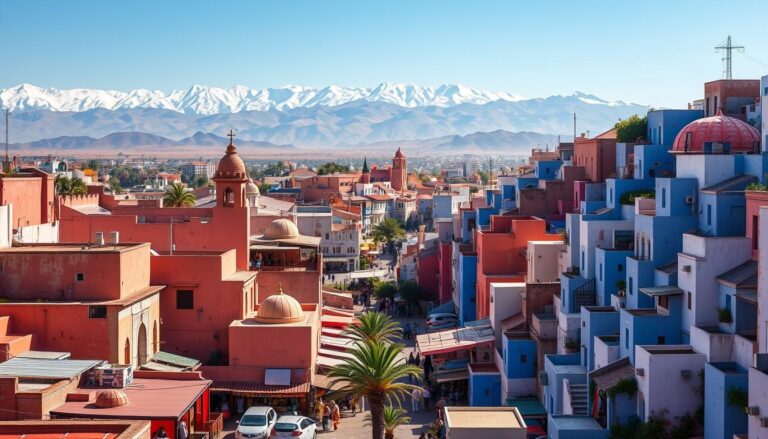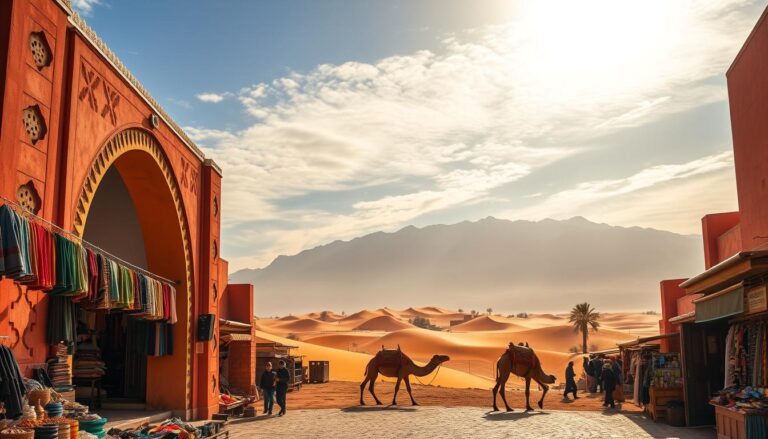Vibrant Cities in Morocco You Need to See
Table of Contents
Cities in Morocco
Did you know Morocco welcomed over 14 million visitors in 2023? This North African gem isn’t just a desert kingdom—it’s a living mosaic where every corner pulses with stories older than time. Picture labyrinthine markets fragrant with spices, cobalt-blue alleyways glowing under the sun, and modern skylines kissing ancient fortresses.
You’ll find destinations here that defy expectations. Wander through medinas where artisans craft treasures using techniques unchanged for centuries. Stand in awe of architectural marvels like Hassan II Mosque, where ocean waves crash against stone pillars. Or lose yourself in the quiet magic of mountain towns painted in shades of indigo.
This isn’t just travel—it’s time travel. Imperial capitals whisper tales of dynasties past, while coastal hubs buzz with contemporary energy. Whether you crave the serenity of Sahara sunsets or the thrill of bargaining in bustling souks, these urban wonders deliver unforgettable moments at every turn.
Key Takeaways
- Morocco blends ancient traditions with modern energy in its urban centers
- Each location offers distinct experiences, from seaside vistas to mountain retreats
- Iconic spots like Marrakech and Fes showcase centuries of cultural heritage
- Local markets provide authentic opportunities for cultural immersion
- Optimal travel seasons vary by region for the best experience
Introduction to Morocco’s Vibrant Urban Scenes
Step into a land where ancient medinas hum with life beside sleek urban cafes. This country thrives on contrasts—snow-dusted peaks tower over palm-lined boulevards, while centuries-old craftsmanship shares streets with contemporary art galleries. Every turn reveals layers of history woven into modern energy.
Overview of Urban Life
Morocco’s heartbeat pulses through its dynamic street scenes. You’ll smell freshly baked msemen as shopkeepers arrange leather goods using methods from the 11th century. The climate varies dramatically—coastal breezes cool Rabat’s whitewashed walls, while Marrakech’s ochre buildings soak up desert sun.
| Region | Best Season | Highlights |
|---|---|---|
| Coastal Areas | Spring/Fall | Mild temps, festivals |
| Atlas Mountains | Summer | Hiking, Berber villages |
| Sahara Gateways | Winter | Stargazing, camel treks |
What to Expect on Your Journey
Your days will swing between discovery and delight. Sip mint tea with rug merchants in Fes, then watch sunset paint the Atlantic coast gold. The cultural mix—Arab calligraphy meets Spanish flamenco rhythms—creates surprises at every corner. Locals greet visitors like old friends, sharing stories over shared tagines.
Pack light layers for microclimates that shift faster than market bargains. From April’s almond blossoms to November’s olive harvests, each season unlocks new flavors and festivities. This destination rewards curious travelers with memories that linger like desert campfire smoke.
Exploring the Rich Heritage of Moroccan Cities
What if walls could talk? You’d hear empires rise and fall through every carved cedar beam and mosaic tile. Morocco’s urban landscapes serve as open-air history books, where ancient craftsmanship meets living traditions.
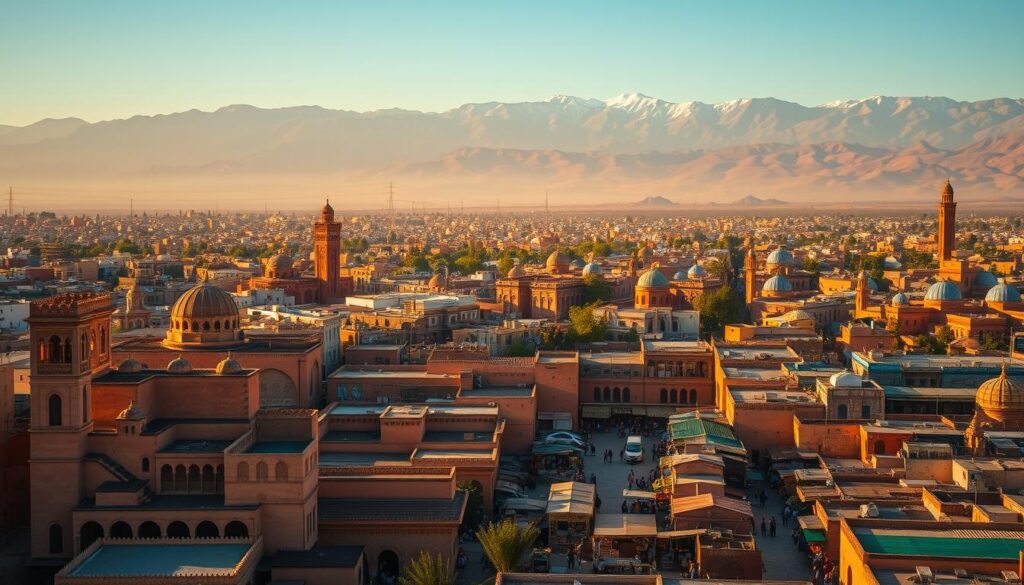
Historical Insights and Cultural Stories
Walk through neighborhoods older than some countries. Volubilis’ Roman columns stand beside 12th-century madrasas, revealing how civilizations layered their mark. “Every stone here holds three stories,” says a Fes artisan shaping brass lanterns near Al Quaraouiyine University—the world’s oldest existing degree-granting institution.
Dynasties like the Almoravids left fortress-like walls, while the Saadians gifted elaborate mausoleums with honeycomb plasterwork. You’ll trace trans-Saharan trade routes through arched gateways where camel caravans once unloaded gold and salt.
Traditions and Timeless Architecture
Watch craftsmen press wet clay into geometric patterns using techniques unchanged since 1070 CE. Nine UNESCO World Heritage sites showcase this living heritage—from Marrakech’s rammed-earth ramparts to Essaouira’s star-shaped bastions.
Modern restoration projects blend seamlessly with original structures. In Meknes, 17th-century granaries now host art exhibitions beneath vaulted ceilings. This harmony of old and new lets you sip espresso in courtyards where sultans once held court.
Casablanca: Modernity Meets Tradition
Where does a nation’s pulse beat loudest? Look no further than this coastal dynamo—Morocco’s largest urban hub merges skyscrapers with spice-scented alleyways. Here, fishermen mend nets near glass-walled offices, while Art Deco facades frame bustling markets selling handwoven textiles.
Marvel at Hassan II Mosque
Your tour begins at a modern wonder rising from Atlantic waves. The mosque’s 690-foot minaret—the world’s tallest—guides ships like a celestial lighthouse. Inside, Venetian marble floors reflect intricate cedar ceilings carved by master craftsmen. Time your visit for sunset when the ocean crashes against transparent glass floors.
Oceanfront Charm and Urban Energy
The Corniche’s crescent-shaped promenade lets you taste Casablanca’s dual soul. Sip espresso at a retro 1930s café, then watch surfers ride waves beneath hotel towers. Don’t miss the Habous Quarter, where French colonial arches shelter traditional bakeries kneading dough for msemen pancakes.
This city thrives on contrasts. Modern malls showcase Berber silver jewelry steps from workshops pounding brass trays. By night, rooftop bars mix cocktails with views of the illuminated mosque—proof that heritage and progress dance beautifully here.
Marrakech: The Red City Experience
What if a city could paint with all five senses? Marrakech answers this daily through rose-hued walls that glow at dawn and alleyways humming with woodsmoke and orange blossoms. This UNESCO World Heritage site wears its “Red City” nickname like a crown, blending earthy tones with bursts of cobalt and saffron.

Wandering Through Bustling Medina Streets
Lose yourself in the medina’s living tapestry. Narrow streets curve past stalls piled with argon oil and hand-hammered copper. You’ll hear leatherworkers tapping babouches before seeing their rainbow displays. The air thickens near spice souks—cinnamon and cumin competing with rose petal piles.
Turn any corner to find hidden riads. These oasis-like homes feature tiled fountains and lemon trees. Locals call these passageways “the city’s veins,” carrying lifeblood between markets and mosques.
Nightlife and the Magic of Djemaa el-Fna
As stars appear, follow drumbeats to the el-fna square. By day, it’s a snake-charmer’s stage. By night? A carnival of sizzling lamb skewers and storytellers’ dramatic whispers. Try fresh-squeezed orange juice as acrobats flip through firelight.
| Time | Atmosphere | Must-Try |
|---|---|---|
| Morning | Quiet markets | Mint tea in shaded cafes |
| Afternoon | Artisan workshops | Henna art demonstrations |
| Night | Energetic crowds | Shared tagine platters |
The square becomes the heart of nightlife after dark. Food carts steam with snail soup while musicians pluck guembri lutes. It’s raw, real, and utterly unforgettable—proof that Marrakech’s magic only deepens with moonlight.
Chefchaouen: The Enchanting Blue Pearl
Ever walked through a watercolor painting come to life? This mountain-hugged city bathes visitors in endless shades of cerulean and cobalt. Buildings cascade down hillsides like spilled indigo ink, creating a dreamscape where even stairways glow with blue-washed charm.
Stroll Through the Blue-Tinted Alleys
Let your feet guide you through curved streets that feel like secret passages. Each turn reveals deeper blues—sapphire doorframes against periwinkle walls, turquoise pots spilling scarlet geraniums. Local lore says the tradition began with Jewish refugees in the 1930s, though residents now refresh the hues annually using natural pigments.
Pause at family-run cafes serving honey-drenched pancakes with mint tea. Watch weavers spin wool into striped blankets using methods unchanged for generations. The Rif mountains frame every vista, their green slopes contrasting with the azure maze below.
This place moves at a rhythm that invites lingering. Unlike busier urban centers, mornings here mean listening to fountains babble beside quiet plazas. Evenings bring shared laughter over clay tagines in tucked-away courtyards.
Artisan shops display hand-embroidered linens and walnut-stained pottery—treasures you won’t find elsewhere. Modern guesthouses blend seamlessly into the blue tapestry, offering visitors rooftop terraces for stargazing above the luminous medina.
Fes: Journey Through Ancient History
Ever tasted history? Fes delivers it through sun-baked alleyways and centuries-old craftsmans’ workshops. This UNESCO World Heritage site isn’t just Morocco’s spiritual heart—it’s a time capsule where medieval life thrives beside modern curiosity.
Navigating the Labyrinthine Medina
Your adventure begins where GPS fails. The medina’s 9,400 alleys twist like a living puzzle—donkeys carting wool brushes past 12th-century madrasas. “Getting lost here means finding yourself,” laughs a local potter shaping clay near Bou Inania Mosque. Follow the scent of cedarwood to hidden squares where calligraphers ink Quranic verses on parchment.
Discovering Traditional Tanneries
Prepare your senses for the Chouara Tannery’s rainbow vats. Craftsmen stomp hides in stone pools dyed with poppy red and saffron yellow—a technique unchanged since 859 CE. Grab mint leaves to soften the pungent aroma as workers explain their family heritage in the trade. Nearby stalls sell buttery-soft bags stamped with patterns seen in Fes’ ancient mosques.
This city doesn’t just showcase history—it lives it. Watch coppersmiths hammer lanterns near Al-Attarine Madrasa, its zellige tiles glittering like frozen starlight. Every corner whispers tales of dynasties who shaped Morocco’s identity, inviting you to become part of its enduring story.
Essaouira: Coastal Charm and World Heritage
Imagine a place where salty breezes carry centuries of stories. Essaouira’s whitewashed medina meets cobalt fishing boats along windswept shores. This UNESCO World Heritage Site blends fortified history with beachside serenity, offering a refreshing counterpoint to bustling interior hubs.
Exploring the Historic Medina and Ramparts
Walk atop 18th-century stone walls where cannons still face the Atlantic. Below, artisans carve thuya wood in shadowed alleyways—a craft perfected over generations. The scent of grilled sardines drifts from harbor stalls, inviting you to feast where fishermen unload their catch.
Days here flow between discovery and relaxation. Browse galleries showcasing vibrant Gnaoua culture, then ride horseback along endless beaches. As sunset paints the sky, climb the Scala du Port for panoramic views where sea meets ancient defenses.
You’ll treasure the rhythm of coastal life here. Morning activities might include kite-surfing on breezy waves, while evenings bring live Andalusian music drifting through arched doorways. It’s authentic magic—preserved yet alive, timeless yet welcoming.


